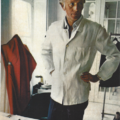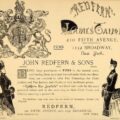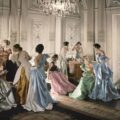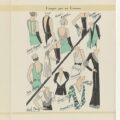Orry-Kelly – costume designer of the Golden Age of Hollywood
July 28, 2016Orry-Kelly was a wonderful costume designer who worked during the Golden Age of Hollywood, costuming (and offending) Marilyn Monroe in Some Like It Hot, Ginger Rogers, Barbara Stanwyck, Rita Hayworth, Ingrid Bergman in Casablanca and Bette Davis in just about everything. At one point he was costuming sixty movies a year, and he had the magical talent of having a piece of gossip, vicious or adoring, about every one of his stars. Orry-Kelly was also the boyfriend of actor Cary Grant, and the two men lived together openly in a tumultuous relationship.
Before his entry into the world of costumes Orry-Kelly had been a straight man for a racetrack thief, a straight man in comedy acts on the stage, he had had businesses printing shawls and painting ties to make ends meet, moved into painting scenery for the stage and doing opulent interiors for the illegal nightclubs in Prohibition America, and from there to stage costumes and finally went into costumes for movies.
Orry-Kelly was born Orry George Kelly in Kiama, Australia in 1897. He hyphenated his name when he started working at Warner Brothers in 1932 and was told to “Fancy it up” – the head of production at the time, Walter Koenig, wanted him to adopt a French version but that was as fancy as he’d go. To his friends, he was Jack.
His background was well to do and he was privately educated. In fact, whatever scrapes he got into Orry-Kelly could always rely on Mother for money, which she sent willingly, never apparently disapproving of his risqué lifestyle. He remained his mother’s baby for the rest of his life, regularly visiting and receiving loving letters reminding him to keep his bowels open. His father, however, was not so fond of young Orry-Kelly’s rather camp ways, kicking apart a toy theatre that the little boy had zealously decorated and costumed. He did, however, name a prize winning shocking pink carnation that he had hybridized after his son.
Sydney’s Shady Underworld
As soon as he could, at 17 Orry-Kelly moved out of his small town and straight to Sydney, hoping to make it as an actor. In his autobiography, “Women I’ve Undressed” Orry-Kerry loved talking about all his shady friends, the prostitutes, bootleggers and con-artists who he found himself hanging out with just as much as the big names he later came to know in Hollywood.
There are plenty of eye-popping descriptions of the “Two Shilling Girls” who he drank with in Sydney. In fact, he claims he innocently lost his virginity to a woman who he thought hadn’t quite been able to remove the last traces of her stage makeup. She took him down an alleyway and relieved him of his bus fare home into the bargain.
According to Orry-Kelly, “Sydney’s fanciest floozies” in the 1910s had named themselves after the popular British Gaiety Girls like Elsie Lily and Rosie Boote, and donned a black-and-white “uniform” starting with a black satin dress. “Their hats were varied – some wore swathed turbans that veiled their eyebrows, others had white aigrettes or pale bird-of-paradise feathers jutting up from the crown and white fox furs slung over one shoulder, the head always biting the tail. They wore enormous corsages of white camellias, white double violets, and bouvardia backed with maidenhair fern. It was an age of elegance and even the prostitutes were elegant. They looked like Aubrey Beardsley drawings.”
The Professional Escort
Orry-Kerry had parts in revue and in the chorus in Sydney, and in a time when people were crazy for tea dances worked as a professional ballroom dancer – and escort. “I was soon in demand with the rich, racy set.” He had English clothes ordered from Bond Street, and lived in hotels which cost double his salary. Suddenly feeling disgusted with himself, and out of his depth with the reputation he had made for himself, he called his mother. She bought him a ticket and used her influence to get a quick visitor’s visa to sail to America, fast.
Orry-Kelly and Archibald Leach
It was in New York that Orry-Kelly met Archibald Leach, who had been locked out of his bedroom in the rooming house Orry-Kelly was staying in. Orry-Kelly took him in. Archie was an out of work actor, who toured with vaudeville troupes, firstly doing stilt walking and juggling, but his dream was to be a real actor, treading the boards. When he wasn’t touring, he lived with Orry-Kelly, and Orry-Kelly let him in on whatever he was into to make money at the time.
Archie helped print his shawls, paint his ties, or hand-finish invites for his client’s parties. If nothing else was forthcoming and the pair were desperate, Leach shared in the money that Orry-Kelly’s mother wired over. Orry-Kelly got Archie Leach a few acting jobs too, though apparently he started out as a lousy actor, learning as he went along. He also scored him a screen test – in fact he got him two. For the first, Leach was deemed just too handsome. For the second, he was in the shadows, which deepened the cleft in his chin and enhanced his cheekbones, making him look older. “We’ve got ourself a new Clark Gable!” cried the studio head. Archie Leach was in the movie business, and changed his name to Cary Grant.
Cary Grant, the meanest film star
But Cary Grant was like a mask that Archie slipped into more and more often, and Orry-Kelly didn’t like it. Cary Grant was violent, punching Orry-Kelly during drunken arguments, and physically throwing him out of cars. He was also extremely tight with money. Though they both moved around a lot, the two men often lived together or dined together every night.
On moving to Hollywood, Orry-Kelly says that Leach wanted to move in with him again but he thought that their lifestyles didn’t match; Orry-Kelly had a lovely little electric kitchen that he wanted to use whilst Leach preferred to dine out in drug stores every night. Orry-Kelly suggested that Leach move in with Randolph Scott, and Leach and Randolph had a lovely twelve year relationship, pictured in magazines together running through the surf and, ironically enough, cooking in the kitchen together in aprons.
Orry-Kelly and Leach did remain friends for a while, but pretty much the nail in the coffin seems to have been when Orry-Kelly phoned to invite Leach to a party and Leach told him that he owed him $360.48. Leach had added up various bits and pieces over the years, half of the dinner bills he had occasionally paid; little treats of paying for tickets to a fight. At the party, Orry-Kelly handed over the wad of cash, and though Leach looked embarrassed and said that he’d been drunk when he demanded the money he did accept it, and that was more or less that. But just one coda: Cary Grant was a pallbearer at Orry-Kelly’s funeral when he died, thirty years later.
Orry-Kelly and his adventures
Orry-Kelly talked about Archie a lot in his autobiography and was clearly devoted to him, but maintained a discreet silence on their sex life. Not so much for his adventures with high class female prostitutes throughout his life, or an adventure in Tahiti where he tracked down the painter Paul Gaugin’s son, Emil. “I looked at the virile twenty-nine-year-old Emil, born with all the elements of his father’s blood and the tropical beauty of his Polynesian child-mother; his liquid eyes gleamed like black leopard dots as he gazed across the purple Pacific. The sky turned to oxblood, everything went pitch black… Much later [we drove home]”
Interiors, invites, and vintage costumes
Orry-Kelly’s costuming career, meanwhile, came about as he was an all round artistic type, able to put his hand to almost anything. In the Art Deco 1920s black and gold was fashionable for everything, including interiors. After a friend painted his entire apartment black, he found it a little oppressive so asked Orry-Kelly, then more the canvas-and-brush type of artist, to liven it up a little. Kelly painted gold dragons with scarlet tongues but perpetually a little drunk as he was, spilled the red paint so had to extend the lolling red tongues all over the room.
After that he planned the luxurious interior decor of various speakeasies, specialising in cheeky frogs with their backs turned, who looked as if they were fiddling with themselves. From there it was a short hop to theatre scenery, but as one theatre impresario noted: “Kelly, you a’e much bette’ d’ess design’ than you a’e scenic.” Orry-Kelly took over a wardrobe department for a whole string of theatres.
Orry-kelly – Imaginative theatricals
One of his first major successes was in a scene where “Girls in beautiful white feathered costumes with a swan’s head on one glove, were grouped around a glass lake. Gradually the scene came to life. The fronts of the costumes were just enough to get by the Boston censors. The critic acclaimed my work. One wrote: “What happened? The Schuberts have done something with charm and without spangle.” From then on, “without a spangle” became a watchword.”
Another design he was most proud of was a scene where girls with elaborate headdresses representing different countries appeared and stood in formation. When they slowly turned around, the backs of the headdresses formed the skyline of New York City. For this idea he was paid $1500. Later, down on his luck, he was outraged to be offered $15.00 for a whole set of drawings.
But he bounced back. When he was engaged at Warner Brothers, his salary was astronomical and he was most proud to have re-negotiated it himself, without an agent.
Without a Spangle
Although Orry-Kelly remembered his motto, “Without a spangle”, his design style was not as simple as he he seemed to think. Certainly, by the standards of the time and the enormous frou-frou costumes some of the stars were put in, he pared it down, but feathers, fringes, sequins, beading and tassels were much in evidence. His skill seems to have been in being sympathetic to the star’s figures: padding was greatly used by the 1930s, not only on shoulder pads and in bras but on hips, too, and he often used it to even out an actresses’s figure by padding one side more than the other. He describes early breast enhancement where vinyl or even paraffin were injected directly into breasts by doctors, making them hard as rocks.
Orry-Kelly swept many stars to fame by changing their personal style or suggesting modish new cropped haircuts. He remembered who did and did not thank him prettily for it, too.
Orry-kelly, Oscars and offending Marilyn Monroe
One star who definitely did not appreciate his input was Marilyn Monroe. Dressing her and her co-stars, Tony Curtis and Jack Lemmon for Some Like It Hot he says he was shocked by how much weight Marilyn had put on, and proposed putting her in ‘shiny satin on her top shelf and dull crepe on her bottom’’ to disguise her figure. “She blushed immediately. Temper, not temperament, took over. She pointed her finger at me and started babbling, ‘‘He said boys’ arses are smaller than girls’ arses and he said that Tony Curtis’s arse was smaller than mine, and I told that one’’ — pointing at me — ‘‘that some people like girls’ arses and some people like…’’
His strategy obviously worked though, as Some Like It Hot went on to win an Oscar. Orry-Kelly’s work was famous in his lifetime, and he designed the clothes for 295 films in total, with Oscars for An American In Paris, and Les Girls too.
An army private
During World War Two, he applied to join the army and was accepted, despite his apparently having the lowest IQ out of 1700 men stationed at St Petersburg. He mostly dug latrines, and was discharged early over his alcolism.
‘‘My short stay in the regular army made me regain values,’’ he wrote. After the war he went back to the studios.
Orry-Kelly had always been a man who “liked his nips” and many of his stories start with “In my cups…” In Prohibition America he was never short of a cocktail and even briefly ran his own speakeasy before his Hollywood days. Although he had made a deal with himself by then never to drink whilst on studio time, he says he often worked through huge hangovers. Eventually he swore he had given it up, along with the pills that he was also fond of.
orry-kelly died of liver cancer in 1964. The pallbearers at his funeral were Cary Grant, Tony Curtis, Billy Wilder and George Cukor. The eulogy was read by Jack Warner.











